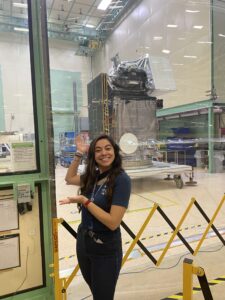Corrine Rojas is a scientific programmer in the ocean ecology lab at NASA’s Goddard Spaceflight Center.
Before we dive into your work with PACE, what is your favorite ocean- or atmosphere-related book or movie?
I’m a big fan of ridiculous sci-fi/horror movies, and when it comes to the depths of the ocean, Sphere (1998) is one of my favorites in that genre. It’s a psychological thriller with everything you’d ever want – logistically impossible ocean research vessels, Hollywood science, aliens, spooky deep-sea fish, and even Queen Latifah!

What is your background? What do you do for PACE?
Before PACE, I worked on a lunar mission called Lunar Reconnaissance Orbiter, and then a couple of Mars missions including the Curiosity and Perseverance rovers. And now I’m here, back down to Earth! I’m doing science operations for Earth missions that look at ocean ecology. And there is just so much life to track here! Doing science operations, I’m a liaison between the engineering team that will control the spacecraft and the scientists that will be monitoring the atmosphere and the ocean ecology. I have to have a background in both science and engineering. I moved to Maryland from Arizona, and before PACE I was working on the Jezero Delta on Mars, near where the Perseverance rover landed. So, I’m coming in from two different deserts, and I now live much closer to the ocean flora and fauna looking at the ocean from space for a living. I feel like a little alien!
What does programming and science operations entail?
As a programmer, I’m developing tools that will tell the spacecraft where to look. Once we’re in orbit, I’ll make sure that the science team gets their priority observations. For example, if someone’s out on a research cruise collecting samples in the open sea, we can time the spacecraft to take pictures overhead which will be a really good data point for them. We’re making sure those scientists are getting what they want and packaging these spacecraft commands in a way that also works with the mission operations schedule.

What advice would you give other early career scientists or other people looking to get into science operations or finding their space in… well, space?
I didn’t always see myself working at NASA. I studied political science for a few years before coming into geography and that’s my academic background – modern day geography translated into programming.
But really, what has opened the door to having this as a career, is my love for maps. Creating and reading maps has always been a passion of mine. And that passion translated to creating maps of the surface of the Moon and the geology of Mars through NASA missions. I’m grateful that NASA needs a variety of disciplines to make a mission possible.
NASA has jobs that range from computer programmers like me, to mechanical engineers and scientists, but also writers and photographers. Even finance folks. It takes a lot of different disciplines to make a NASA mission work. And if you find something that you really enjoy, there’s probably going to be a related job that can take you to working on a mission.

What are you most looking forward to post-launch?
That’s when my job really starts! After the spacecraft is commissioned, we’ll start commanding the sensors to take scientific observations. I’m looking forward to working with the world’s best oceanographers and atmospheric scientists, making sure that they’re getting the data they want. Hopefully we’ll have more answers regarding Earth sciences and climatology studies, especially aerosol studies since we don’t have a lot of that data. All this data will help anywhere from fisheries to disaster management and more. Everyone relying on that data is about to get a firehose of information, and I’m excited to see them dig into it.

What is a fun fact about yourself? Something that people might not know about you?
I’m a newbie, but I weightlift pretty consistently. It’s just something that I enjoy doing that takes me away from the screen and into the present moment. I can just focus on the here and now, and my body getting really strong and staying healthy.
What is one catch-all statement describing the importance of PACE?
PACE is going to help us track the heartbeat of ocean, from a few meters below the sea surface all the way up to the top of the atmosphere.

Header image caption: Corrine Rojas during one of her many walks around Washington, D.C. during cherry blossom season. Image Credit: Corrine Rojas
Erica McNamee, Science Writer at NASA’s Goddard Space Flight Center

